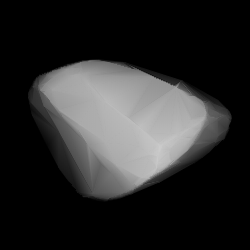Physical characteristics
In the Bus–Binzel SMASS classification, Pickeringia is a common, carbonaceous C-type asteroid. [3]
Rotation period
In January 2017, a rotational lightcurve of Pickeringia was obtained from photometric observations by the Spanish group of asteroids observers (OBAS). Lightcurve analysis gave a rotation period of 13.144±0.005 hours with a brightness variation of 0.17±0.03 magnitude ( U=2+ ). [11]
The result supersedes observations taken during the 1990s by European astronomers using the ESO 0.5-metre telescope at La Silla Observatory, Chile, which gave a period of 13 hours with an amplitude of 0.40 magnitude ( U=2 ). [15] as well as a period determination by French amateur astronomer Laurent Bernasconi in December 2004, which gave 13.17±0.05 h and an amplitude of 0.20±0.01 magnitude ( U=2 ). [16]
Modeled lightcurve
Two modeled lightcurves, published by Josef Ďurech and Josef Hanuš in 2016, using photometric data from the Lowell Photometric Database (LPD) and other sources, gave a sidereal period of 13.16995±0.00001 and 13.16998±0.00005, respectively. Each modeled lightcurve also determined two spin axes of (99.0°, 67.0°) and (283.0°, 30.0°), as well as (282.0°, 35.0°) and (103.0°, 68.0°) in ecliptic coordinates (λ, β), respectively. [17] [18] The online version of the Database of Asteroid Models from Inversion Techniques gives two poles at (103°, 68.0°) and (282°, 35.0°) with a nearly identical sidereal period. [a]
Diameter and albedo
According to the surveys carried out by the Japanese Akari satellite, the NEOWISE mission of NASA's Wide-field Infrared Survey Explorer (WISE), and the Infrared Astronomical Satellite IRAS, Pickeringia measures (74.89±0.92), (75.596±0.311) and (89.42±3.4) kilometers in diameter and its surface has an albedo of (0.080±0.002), (0.086±0.014) and (0.0555±0.005), respectively. [7] [8] [9] The Collaborative Asteroid Lightcurve Link derives an albedo of 0.0423 and a diameter of 89.19 kilometers based on an absolute magnitude of 9.3. [19] while Carry gives a diameter of 82.52±7.18 km and estimates a mass of (3.74±0.32)×1018 kilogram from an unrealistic density of 12.70±3.49 g/cm3 . [10] Alternative mean-diameter measurements published by the WISE team include (70.14±18.05 km), (89.13±13.47 km) and (89.673±1.178 km) with corresponding albedos of (0.049±0.348), (0.0552±0.0109) and (0.06±0.02). [5] [19] On 7 August 2008, an asteroid occultation of Pickeringia gave a best-fit ellipse dimension of (89.0 km × 89.0 km), with a poor quality rating of 1. These timed observations are taken when the asteroid passes in front of a distant star. [5]
This page is based on this
Wikipedia article Text is available under the
CC BY-SA 4.0 license; additional terms may apply.
Images, videos and audio are available under their respective licenses.
